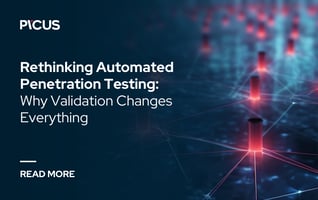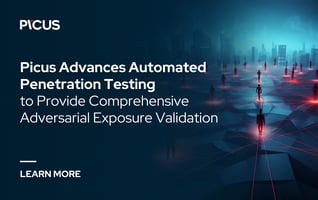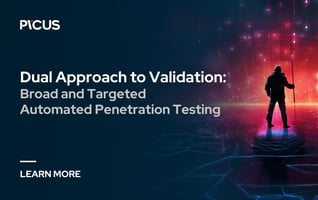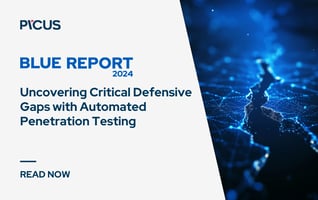What Is Attack Path Analysis?
Attack Path Analysis (APA) is a cybersecurity technique used to proactively identify, visualize, and analyze all the possible routes an attacker could take through an IT environment to reach critical assets. In practice, it maps how vulnerabilities, misconfigurations, and access weaknesses can be chained together into “attack paths” that adversaries might exploit. This enables security teams to mitigate these paths before they can be used in an actual attack.
However, APA by itself does not have the inherent capability to validate whether these paths are practically exploitable. It analyzes theoretical routes but cannot confirm if each step in a chain can actually be executed in a live environment. To overcome this limitation, some platforms like Picus combine attack path analysis with automated penetration testing within a single tool. This integration enables the validation of attack paths by safely simulating adversary techniques, helping organizations focus on the most critical and exploitable paths rather than relying on assumptions alone.
In this blog, we explain what attack path analysis is and how, when combined with automated penetration testing, it can become a powerful way to improve your security posture.
The Importance of Attack Path Analysis: Benefits of APA
Attack path analysis provides several important benefits that improve an organization’s security posture. By understanding potential attack paths in advance, security leaders can make more informed decisions about where to focus their efforts. Key benefits of APA include:
Improved Risk Visibility: Attack Path Analysis provides a clear, continuous view of how an attacker could move through your environment, exposing blind spots and hidden gaps that traditional assessments often overlook. By dynamically mapping interconnected weaknesses, it helps teams understand the cumulative risk of exposures in context rather than in isolation. This perspective supports building a more adaptive and resilient security architecture over time.
Figure 1. Picus APV Showing Paths to Your Critical Assets through Attack Path Analysis
Better Prioritization of Defenses: By modeling how an attacker would actually traverse the environment, APA highlights which vulnerabilities or misconfigurations are most dangerous and likely to be used in a real attack. This risk-based insight helps security teams optimize resource allocation, focusing limited time and budget on fixing the weaknesses that would have the biggest impact on breaking attack chains. In short, APA guides defenders to patch or harden what matters most first.
Proactive Threat Detection: Simulating attacker movement through the network helps identify early indicators of compromise that might otherwise go unnoticed. APA enables security teams to recognize suspicious patterns, such as unusual lateral movement or privilege escalation attempts, and set up targeted monitoring to catch them in real time. By anticipating attacker behavior, organizations can detect threats much earlier in the kill chain, often before major damage occurs.
Enhanced Incident Response Preparedness: Understanding potential attack paths in advance means incident response (IR) teams can prepare playbooks for those specific scenarios. APA effectively “war-games” how an attack would unfold, so the organization can pre-plan containment and remediation steps for likely attack scenarios. When an incident does occur, responders can react faster and more decisively, limiting damage and downtime. This improves overall cyber resilience and business continuity.
Reduced Exposure and Continuous Improvement: By continually uncovering and helping eliminate attack paths, APA steadily shrinks an organization’s attack surface. Each removed path forces attackers to find new, more difficult ways in. Over time, this proactive approach lowers the likelihood of a successful breach. It also supports compliance efforts (by demonstrating a thorough, ongoing risk management process) and strengthens executive confidence that cyber risks are understood and being addressed.
The Process Of Attack Path Analysis: Steps Of APA
To provide a clearer understanding, this section outlines the steps of a complete attack path analysis using the Picus Attack Path Validation (APV) tool. Picus APV works in collaboration with automated penetration testing technology. It identifies and analyzes attack paths within the organization’s domain environment.
|
TL:DR The attack path analysis process begins with an infiltration point of a choice. From there, Picus APV continuously enumerates each new endpoint to get information about domain joined endpoints & users, privileges, misconfigurations, and exposed credentials. Based on this evolving context, the intelligent decision engine dynamically selects the next best technique, whether credential dumping, lateral movement, or privilege escalation, to advance toward the simulation’s pre-decided objective. Rather than evaluating isolated issues, APV uncovers complete attack chains and identifies choke points, in other words, shared steps of multiple attack paths attackers rely on. Eliminating these points helps security teams disrupt the most impactful paths and reduce the risk of full domain compromise. |
Step 1: Data Collection
The first step of attack path analysis is collecting data from the organization’s Active Directory environment. This step should continuously enumerate endpoints, users, groups, sessions, DNS configs, trust relationships, and ACLs.
For instance, techniques like Domain Group Enumeration, Session Enumeration, and Credential Verification are used to surface exploitable conditions such as exposed service accounts or overly permissive ACLs.
It is important to maintain continuous data collection during attack path analysis. As new users, machines, and access points are introduced, they can alter the trajectory of the simulation. These changes may uncover new endpoints and reveal alternative routes, ultimately helping identify the most critical attack paths in real time.
Figure 2. Data Collection and Enumeration
Step 2: Attack Path Mapping
Collected data is analyzed by the Picus Intelligent Decision Engine to construct multi-step attack paths that achieve the simulation objective, such as gaining domain admin access or deploying ransomware.
Note that this is also a continuous practice through an entire automated pentesting simulation.
As Picus APV continues to enumerate additional endpoints, these paths are dynamically updated based on newly discovered information. This adaptive process enables the engine to identify the most stealthy, efficient, and high-impact route to critical assets.
|
For instance, Picus APV may detect a Kerberoastable account, extract its service ticket, crack it offline to obtain the plaintext password, and then, through session enumeration on other endpoints, identify that the same user has local administrator privileges on a separate host using the Parallel Administrator Privilege Check over SMB. |
This sequence forms a viable path for lateral movement and privilege escalation.
Step 3: Threat Simulation
Using safe, in-environment simulations, Picus emulates adversarial actions where possible, including credential access techniques such as LSASS memory dumping, LAPS password extraction, LSA secret dumping, and Kerberoasting. These credentials can then be used to move laterally across other machines within the domain.
The core value of this step is to demonstrate that the identified security weaknesses are not only present but can also be exploited and chained together into an attack path leading to domain administrator privileges.
In short, these simulations validate whether attack paths are exploitable from end to end without impacting production systems. This validation is essential for attack path analysis, as it reveals the true criticality of each path and the level of risk it poses to business continuity. It enables a data-driven understanding of where the most dangerous gaps exist: those that could ultimately grant an adversary full access to the directory environment.
Step 4: Risk Scoring & Prioritization
At the end of each simulation, a graph-based representation of the organization's attack paths within the domain environment is generated. However, not all attack paths pose the same level of risk.
The core purpose of risk scoring and prioritization in attack path analysis is to highlight the most stealthy and critical attack paths that lead to the organization’s crown jewels.
Picus scores each path based on its feasibility, the sensitivity of the final target, and the exploit chain required to reach it.
|
For instance, a path that chains Kerberoasting → Offline Password Cracking → Over Pass the Hash → Code Execution over SMB to reach a Domain Admin account is ranked as critical due to its short length and high-impact outcome. |
Paths that terminate at high-value assets like Domain Controllers, gMSA accounts, or critical file servers are prioritized over those ending in low-privilege endpoints. Even if individual steps are rated “low” (e.g., Session Enumeration, Administrator Privilege Check over SMB), they can elevate the overall risk when combined into a viable lateral movement path toward full domain compromise.
Picus also identifies choke points. In other words, shared techniques or misconfigurations (e.g., Unquoted Service Paths, Modifiable Service Binaries) that appear across multiple attack paths. Fixing these yields broad risk reduction. By chaining and scoring validated techniques, APV highlights which exposures most urgently require attention to prevent domain-wide breaches.
Step 5: Remediation & Validation
For every identified attack path uncovered through Attack Path Analysis, Picus APV recommends precise remediations, such as patching modifiable services, revoking excessive privileges, or isolating vulnerable endpoints.
It then re-tests the same path using in-environment simulations to confirm that the mitigation is effective and the path is no longer exploitable.
Attack Path Analysis Use Cases: When To Use APA
Attack Path Analysis can be applied in a variety of scenarios to strengthen an organization’s security strategy. Below are common use cases for APA and how it provides value in each:
Red Teaming and Penetration Testing Augmentation
Traditional penetration tests and red team exercises are periodic and can only cover so much ground. Attack Path Analysis complements these by automating the discovery of attack routes on an ongoing basis.
Instead of waiting for the next annual penetration test, security teams can use tools and technologies that combine attack path analysis with automated pentesting to simulate and emulate attacker behaviors at any time. This approach helps uncover and, more importantly, validate paths to critical assets that a manual red team might miss due to time constraints.
In short, attack path analysis enhances red teaming by rapidly identifying potential attack paths, allowing human testers to eliminate repetitive tasks and focus on the most critical and creative attack scenarios that automated tools may overlook.
Assume Breach Mindset: Simulating Real-World Scenarios from a CISO’s Perspective
CISOs are often asked: “What would happen if an employee clicks a phishing link?” Attack Path Analysis provides a concrete answer to this question.
With Picus APV, simulations can start from any assumed breach point such as initial access via a phishing email and map out exactly how an attacker could progress from that foothold.
This assumed breach approach mirrors real-world incidents and helps CISOs assess blast radius, validate defenses, and prioritize mitigations. Unlike traditional testing, Picus APV replicates attacker behavior from the inside out, showing how phishing access might lead to ransomware deployment across the entire active domain environment. This closes the gap between hypothetical risk and practical exposure.
Identifying Choke Points in Multi-Step Attack Chains
Attack Path Analysis helps security teams uncover choke points, which are critical steps that attackers must pass through to progress toward their objectives.
|
For example, an attack path may begin by identifying a Kerberoastable service account through SPN enumeration. After exporting and cracking the service ticket offline, Picus APV detects a local privilege escalation opportunity, such as a UAC bypass, to elevate the current user's privileges. With elevated access, further enumeration reveals that the compromised account has admin rights on another machine. The attacker pivots, dumps LSASS, and obtains domain admin credentials. In this case, privilege escalation becomes a critical choke point. Without it, lateral movement and domain compromise are not possible. Attack Path Analysis helps uncover these key junctions, enabling defenders to prioritize and remediate the most impactful weaknesses. |
Picus APV highlights these pivotal moments, allowing defenders to fortify them and break the chain. By simulating how an adversary moves step-by-step, APA enables teams to pinpoint and secure the endpoints that matter most, disrupting entire attack plans at their weakest structural points.
SOC Monitoring and Threat Hunting Optimization
The insights from Attack Path Analysis can greatly enhance Security Operations Center (SOC) effectiveness. APA reveals likely lateral movement routes and attacker techniques, which the SOC can use to fine-tune detection rules and hunting queries.
For example, if APA shows that an attacker would dump credentials and use them to pivot, the SOC can ensure it has detections for abnormal credential dumping or login patterns on those systems. In this way, APA guides SOC teams on where to look for early signs of an attack. It essentially translates theoretical risk into concrete log signals and behavioral indicators to monitor.
Exposure Validation & Risk Assessment
Attack path analysis is a core component of modern exposure management programs. It goes beyond identifying individual vulnerabilities, it validates which combinations of exposures truly put the organization at risk. This helps avoid remediation fatigue; rather than fixing thousands of vulns in isolation, teams concentrate on exposures that form exploitable paths. By discovering and proving out these attack chains, APA provides a more realistic assessment of risk. Security leaders can use these insights to brief executives or regulators, demonstrating which weaknesses could lead to a breach and that they are being addressed with priority.
Compliance and Audit Preparation
Many security frameworks and regulations (PCI-DSS, ISO 27001, etc.) require organizations to assess their security posture and remediate significant risks. Attack Path Analysis helps demonstrate a thorough approach to risk management by documenting how the organization identifies and mitigates complex attack scenarios. By using APA, teams can generate evidence for auditors that not only are vulnerabilities being scanned, but the combined impact of those vulnerabilities is understood and being managed. This level of due diligence – showing that you can map out how an attacker might chain weaknesses to reach sensitive data – greatly supports compliance reporting. It also enables more informed discussions with business stakeholders about cyber risk.
Tools and Technologies Used in Attack Path Analysis
Attack Path Analysis (APA) relies on a combination of technologies that map potential attack routes by replicating adversary behavior across enterprise environments. While APA is highly effective at identifying and visualizing exploitable paths, it does not perform penetration testing on its own. It maps possibilities based on known conditions, like user privileges, trust relationships, and misconfigurations, but stops short of actually testing exploit feasibility in live environments.
However, when used in collaboration with automated penetration testing, APA becomes significantly more powerful.
Platforms that integrate both capabilities, such as Picus APV, not only uncover theoretical attack paths but also simulate real-world attack techniques safely in production environments to validate risk. This integrated approach delivers far deeper operational value.
Discovery and Enumeration Capabilities
APA begins with comprehensive environment scanning. It collects data from an organization’s directory environment (like Windows Active Directory) using techniques like host discovery, session enumeration, ACL analysis, and domain trust mapping. This visibility enables the construction of attack paths that reflect how an attacker could navigate an environment.
Threat Emulation and Exploit Validation
While attack path analysis alone models potential paths, automated penetration testing validates them. In integrated platforms, simulations are used to execute credential access, privilege escalation, and lateral movement attacks to confirm that these paths are not just theoretically possible but practically exploitable.
For instance, after identifying a Kerberoastable account, the platform can simulate retrieving the service ticket, cracking it offline, and using the recovered credentials to escalate privileges or move laterally, just as an attacker would.
Attack Path Mapping and Visualization
APA tools organize findings into clear, multi-step chains that illustrate each phase of an attack—from initial access to privilege escalation and lateral movement. When supported by penetration testing, each step in the chain is validated in the real environment. This results in a live, data-driven attack graph rather than a hypothetical one.
Context-Aware Execution
In platforms that support both APA and automated pentesting, each action is determined by real-time discoveries. The platform doesn’t follow a fixed script. For example, it might choose to exploit a modifiable service or test a cracked credential for privilege escalation, depending on the exact conditions found during enumeration.
Risk Prioritization and Remediation Support
Validated attack paths are scored based on exploitability, path complexity, and the sensitivity of the targeted asset. Those involving chained credential attacks and lateral movement to domain-critical systems rank as the highest priority. Integrated solutions also highlight remediation points—such as exposed credentials or service misconfigurations—that break multiple paths at once. After fixes are applied, revalidation confirms the exposures are closed.
Attack Path Management
Attack Path Management (APM) is the term used to describe the continuous process of discovering, visualizing, and eliminating attack paths in an environment.
In other words, Attack Patch Management takes the insights from Attack Path Analysis and operationalizes them as an ongoing practice.
It involves not only identifying potential attack routes but also quantifying their risk, prioritizing them, and driving remediation as part of a cycle of continuous improvement. The goal of Attack Path Management is to reduce an organization’s overall exposure by systematically breaking the kill chains that attackers could exploit.
The Critical Need For Attack Path Management
Without APM, security teams might fix one problem at a time yet still be “running blind” to how an attacker could string together multiple gaps to reach sensitive data.
|
For example, a minor misconfiguration on one server might seem low-risk until combined with stolen credentials and a lateral move to an unpatched database – suddenly the path to breach is clear. |
APM ensures these connections are not overlooked. It continuously scans for new exposures and changes in the environment, so that as systems are added or updated, any new potential attack paths are immediately flagged for mitigation.
In short, APM is needed to keep pace with the dynamic threat landscape and to preempt complex attacks that would evade more siloed, point-in-time defenses.
Limitations of Traditional Security Approaches
Traditional security approaches like regular vulnerability scanning, periodic penetration tests, and strict identity & access management are all important, but they have limitations that APM addresses.
One limitation is the siloed nature of these controls – each tends to focus on one dimension (just vulnerabilities, or just identity, etc.) and thus may fail to reveal the chain reaction an attacker can trigger across domains.
|
For instance, a vulnerability scan might report hundreds of flaws, and an IAM audit might show some overly permissive accounts; handled separately, you might not realize that one of those flaws could be used by a user with excessive permissions to compromise an entire network segment. |
Another limitation is that traditional assessments are often point-in-time and infrequent. Penetration tests or red team exercises might be done once a year or quarter, leaving long windows where the environment drifts and new attack paths emerge unchecked. Attack Path Management, by contrast, is continuous – it treats security posture as a constantly moving target that needs regular (even automated) analysis. It’s also far more thorough. Manual testing is limited by human time and scope, whereas automated APM tools can systematically enumerate thousands of potential paths and test them much faster. As a result, APM can uncover “toxic combinations” of misconfigurations and vulnerabilities that a human-led assessment might miss.
It’s important to note that APM doesn’t replace traditional measures; rather, it augments them. Patching, access control, and monitoring are still essential. What APM does is find the exploitable gaps that remain despite those efforts. It acts as a safety net and a guide, pointing security teams to high-priority problems that traditional tools in isolation might label as low-risk. For example, a single medium-severity vulnerability might not trigger urgency – until APM shows that it’s the missing link in an attack path to critical data. Thus, APM addresses the limitations of conventional approaches by providing context and continuous oversight of how well all security controls and measures are working together to prevent an end-to-end breach.
|
Example of an attack path traversing a segmented network: The diagram illustrates an attacker (far left) who first compromises a foothold in the Sales network (step 1), then moves laterally to the IT network (steps 3 and 4) before attempting to reach the Production servers (step 5). Direct access to Production is blocked by a firewall, but the attacker finds an indirect route through intermediate systems. This scenario shows why traditional perimeter defenses alone are insufficient – attackers can pivot through internal networks (like Sales to IT) to bypass barriers. Attack Path Management aims to discover and shut down these multi-stage paths by hardening each link (e.g., securing the Sales and IT environments) so that even if an attacker breaches one area, they cannot easily progress to crown jewels. |
Key Advantages of Attack Path Management
Attack Path Management offers several advantages that strengthen an organization’s security posture beyond what point-in-time analyses can achieve:
Continuous, Real-Time Risk Awareness: APM turns attack path analysis into a continuous activity. Instead of periodic snapshots, security teams get an up-to-date view of evolving attack paths as the infrastructure or threat landscape changes. This means new vulnerabilities, system changes, or emerging attacker techniques are promptly evaluated for their impact on attack paths. Continuous awareness helps organizations stay ahead of attackers by removing pathways before they can be exploited, rather than reacting after an incident.
Holistic Risk Reduction: By looking at security holistically, APM ensures that mitigation efforts produce broad risk reduction. Fixing a single weakness can sometimes eliminate dozens of potential attack paths if that weakness was a common link. APM focuses on these high-impact fixes. The result is often a more significant reduction in overall exposure with less effort, as teams concentrate on key choke points. This stands in contrast to traditional approaches that might fix many issues but yield marginal improvement because the critical attack chains were left intact.
Prioritization and Efficient Resource Use: Attack Path Management inherently prioritizes security work based on risk. It quantifies which attack paths pose the greatest threat—considering likelihood, exploitability, and impact—and directs resources to those first. This risk-based approach is especially valuable for teams with limited staff or budgets. It ensures that security efforts always target what matters most. Organizations that adopt APM often find they can do more with less: by focusing remediation on the 20% of issues that remediate 80% of the risk, for example.
Improved Collaboration and Strategy: APM outputs like attack graphs and risk scores create a shared language across teams. IT, SOC, vulnerability management, and executives can all understand how a breach could unfold. This clarity helps align priorities and tie security efforts to business risk. Backed by clear visuals and data, APM also supports budget justification, helping security teams gain buy-in for the resources they need.
Picus Platform As An Attack Path Management Solution
The Picus Security Platform is a prime example of an Attack Path Management solution in action. Picus’s platform offers an Attack Path Validation module that automates the discovery, visualization, and validation of attack paths across an organization’s network. It continuously simulates how an advanced attacker would progress after breaching the perimeter, identifying the exact sequence of steps (exploits, lateral movements, privilege escalations, etc.) that lead to critical assets like domain controllers or databases. By doing so, the Picus platform reveals the truly critical attack vectors and misconfigurations that form those paths, rather than overwhelming teams with a raw list of thousands of issues.
What sets the Picus solution apart is its emphasis on validated risk. Powered by an intelligent adversary simulation engine, it doesn’t just theorize about paths – it safely executes the attack sequence to confirm that each step is possible, providing high-fidelity insight into security gaps. The platform then gives mitigation guidance for each step of the path, so security teams know exactly how to break the kill chain. This might include recommending a patch, changing a configuration, or implementing a compensating control, prioritized by which actions will reduce the most risk. By focusing remediation on the most critical paths, Picus helps organizations fix what truly matters and avoid spending effort on low-risk issues.
In summary, the Picus platform functions as an end-to-end Attack Path Management solution: it discovers attack paths, visualizes them in an intuitive dashboard, validates them through simulation, and assists in eliminating them. As a result, security teams using Picus can achieve continuous, measurable reduction in their exploitable attack surface. The platform illustrates how APM tools can make an otherwise complex practice straightforward, enabling even lean security teams to adopt a proactive, attacker-informed defense strategy.
See How an Attacker Can Reach Domain Admin in 7 Steps
Picus Attack Path Validation mimics real attacker behavior to uncover your most critical paths to crown-jewel assets like Domain Admin accounts. This red team emulation shows how credentials are stolen, cracked, and used to escalate privileges—step by step. In just minutes, security teams gain actionable visibility into where attackers could succeed and where to focus their defenses.








